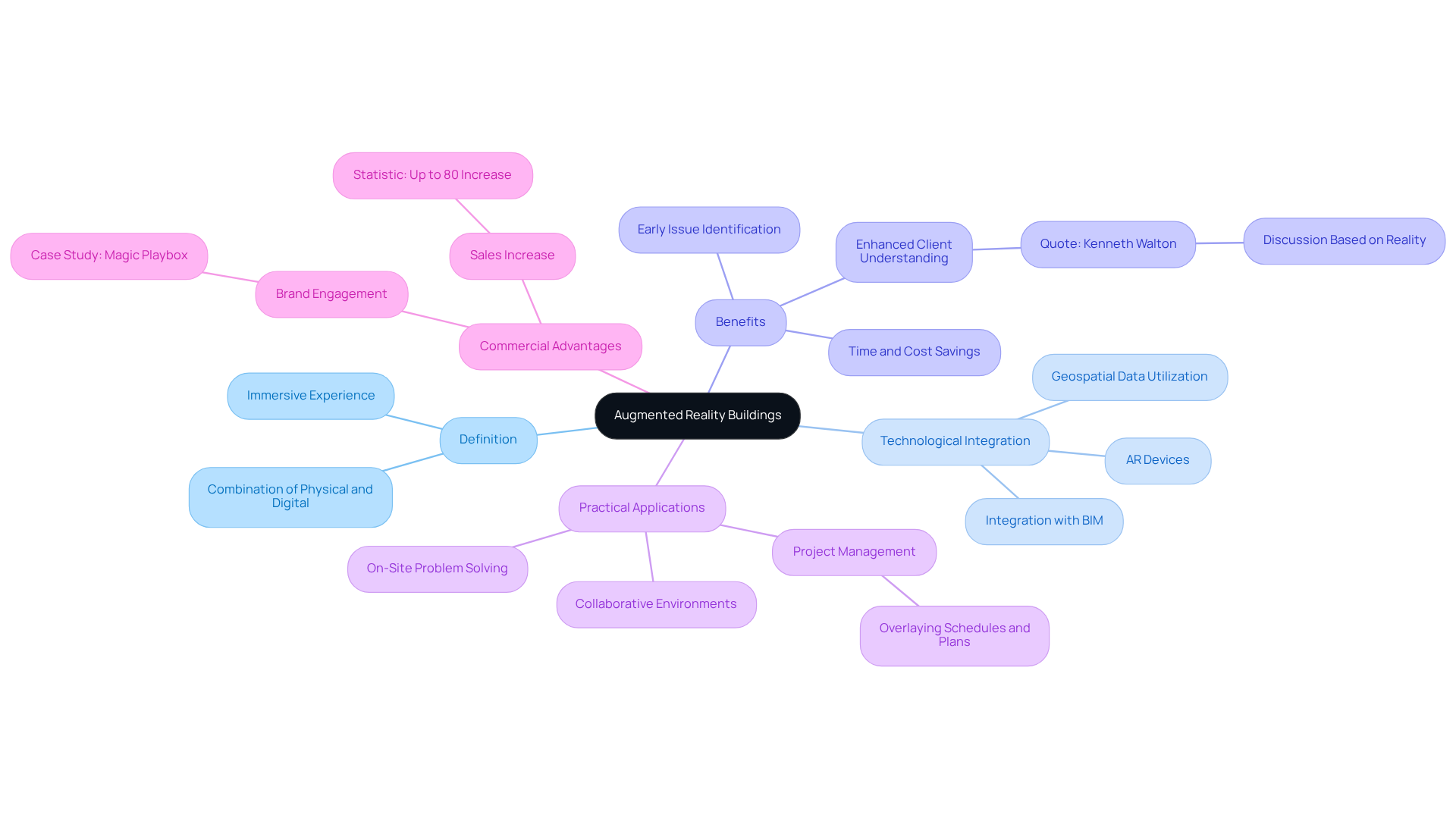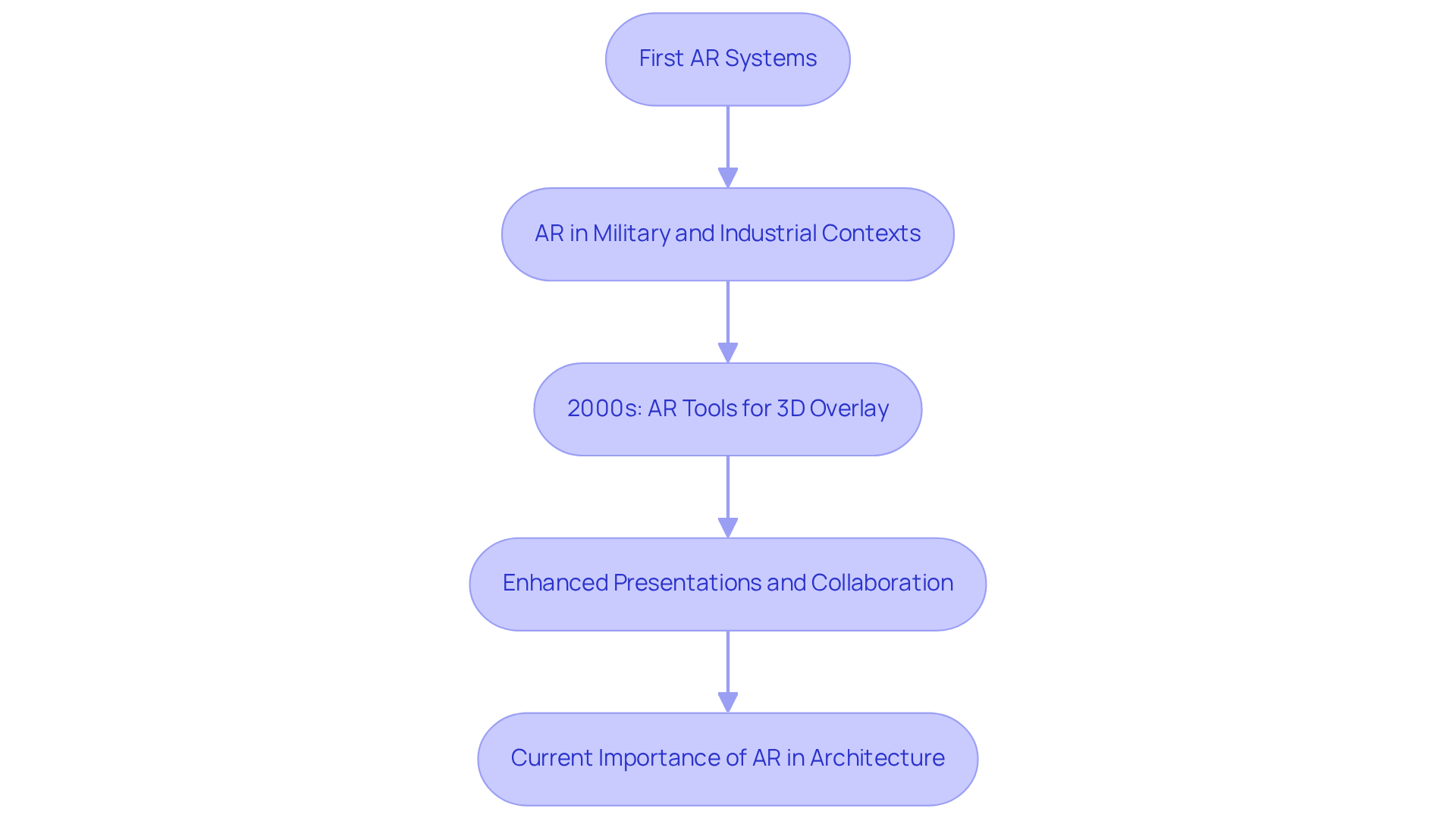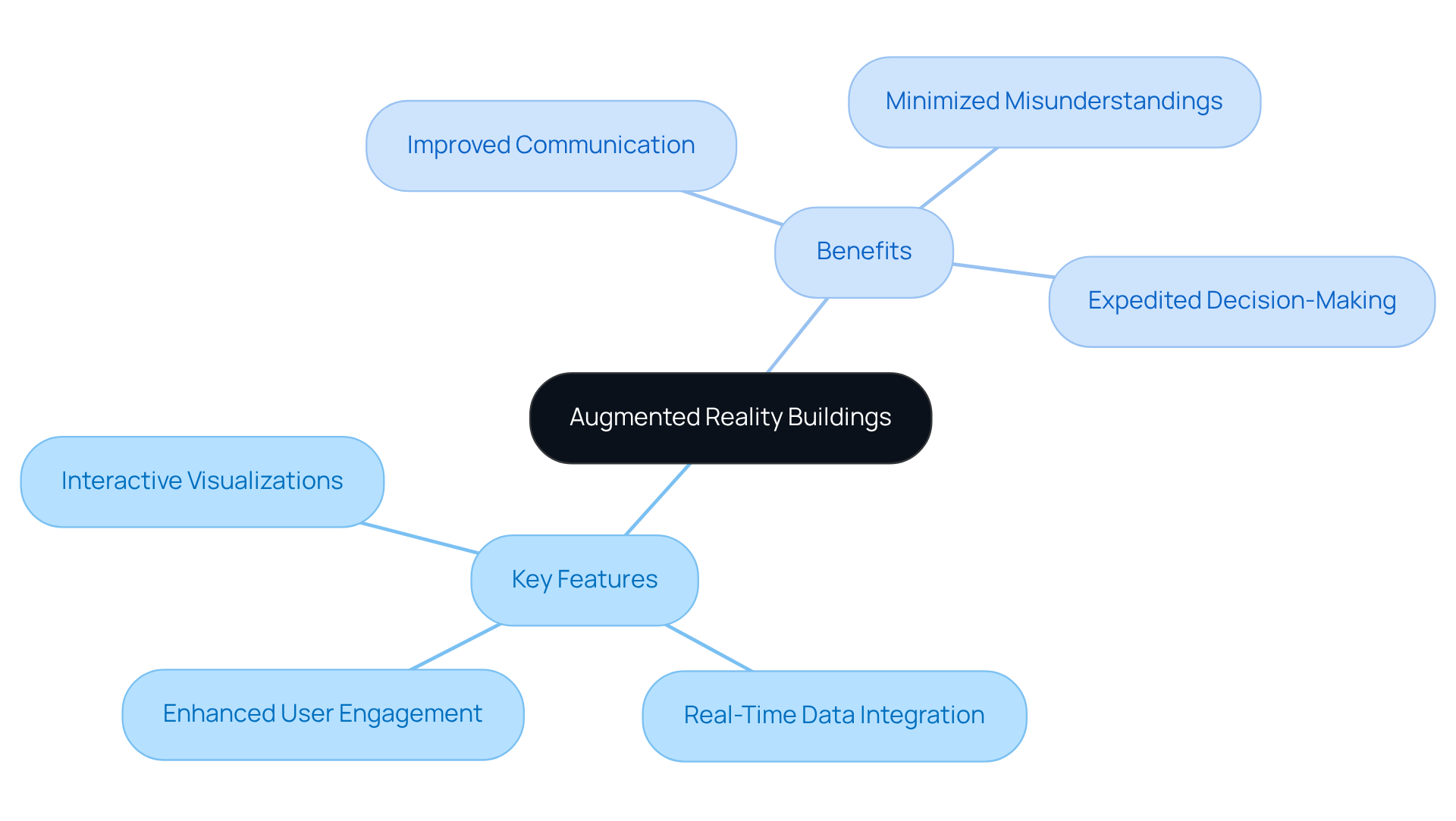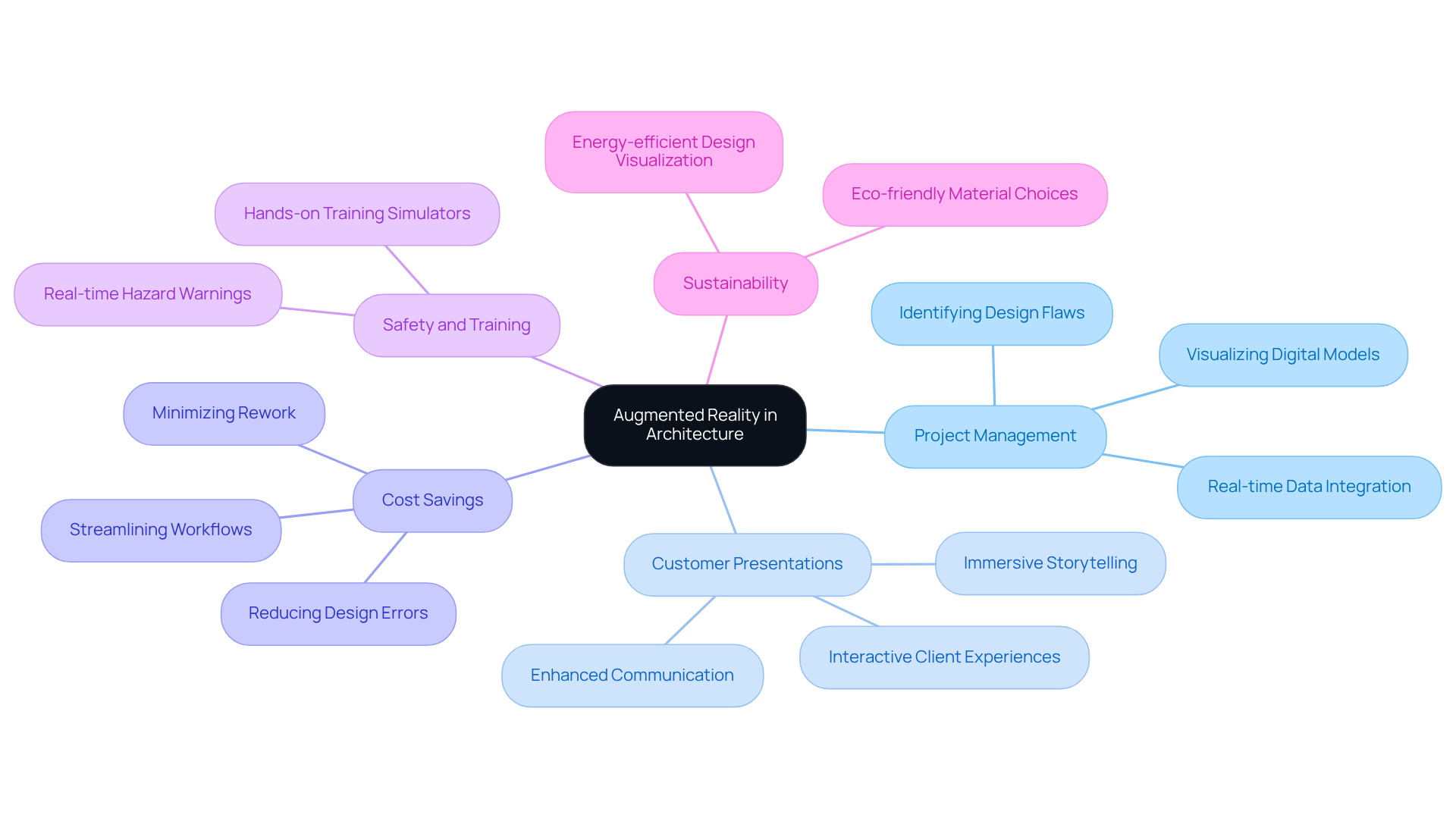Overview
Augmented reality buildings represent a groundbreaking evolution in architectural design, merging physical environments with digital overlays. This innovative approach allows users to interact with both real and virtual elements simultaneously, enhancing architectural visualization and fostering better communication among stakeholders.
Research indicates that these structures significantly improve project outcomes by enabling real-time data integration and delivering immersive experiences. Ultimately, this revolutionizes the design and construction processes, positioning augmented reality as a critical tool for industry advancement. Stakeholders are encouraged to embrace this technology to stay ahead in a competitive landscape.
Introduction
Augmented reality buildings signify a groundbreaking fusion of the physical and digital realms, enabling deeper interactions with architectural spaces. This innovative technology empowers users to experience enhanced visualizations and real-time data integration, fundamentally altering how architects and clients engage with designs.
As this transformative tool gains traction, it is essential to consider its practical applications and the challenges that may accompany its widespread adoption in the industry. Research indicates that the integration of augmented reality can significantly improve design communication and collaboration, making it a vital asset for modern architectural practices.
However, industry standards must be established to address potential obstacles, ensuring that the benefits of this technology are fully realized.
Define Augmented Reality Buildings
Augmented reality buildings signify a revolutionary combination of physical structures and digital overlays, enabling users to engage with both real and virtual environments simultaneously. This innovative technology seamlessly integrates computer-generated images, sounds, and sensory inputs into the real world, crafting augmented reality buildings that create an immersive experience and revolutionize architectural interaction.
For instance, augmented reality buildings, when viewed through an AR device, can unveil additional insights regarding their design, history, or functionality, fundamentally reshaping our perception of architectural spaces. As Kenneth Walton, a designer of buildings and urban spaces, aptly states, 'Augmented reality allows us to have a discussion about impacts with something real to base it on, rather than six or seven different imaginations.' This capability not only enhances customer understanding but also facilitates the early identification of issues, ultimately conserving time and costs in construction.
Furthermore, AR can superimpose schedules, plans, and other critical data onto real-world job sites for effective project management, underscoring its practical applications in the field. The integration of AR in architecture is transforming creation processes, empowering builders to visualize proposed structures in actual settings and engage patrons more significantly. Notably, AR has the potential to increase sales by up to 80% through the incorporation of AR modules, highlighting its commercial advantages for e-commerce brands.
Magic Playbox stands at the forefront of this transformation, pioneering immersive AR solutions that enhance brand engagement and customer loyalty in the marketing and e-commerce sectors.

Explore the Evolution of Augmented Reality in Architecture
The evolution of augmented reality (AR) in architecture commenced in the early 1990s with the advent of the first AR systems, initially utilized in military and industrial contexts. As technology progressed, builders began to explore the potential of augmented reality buildings for visualizing concepts within actual environments.
By the early 2000s, AR tools were developed that enabled designers to create augmented reality buildings by overlaying 3D models onto physical sites, which significantly enhanced presentations for stakeholders and facilitated real-time collaboration. This transformation not only improved interaction between planners and clients but also allowed for prompt modifications and enhancements to plans, bridging the gap between digital ideas and tangible outcomes.
Today, augmented reality buildings are recognized as a vital component in architectural practices, due to their ability to enhance creativity, precision, and efficiency in development processes. The integration of advanced AR technologies, including AI and the anticipated deployment of 5G, is expected to further revolutionize architectural processes, establishing AR as an indispensable resource for contemporary designers.
Noteworthy examples, such as the Louvre Abu Dhabi's implementation of AR for interactive exhibits and Foster + Partners' use of VR for collaborative creation, illustrate the practical applications and benefits of these technologies.
Nevertheless, challenges such as technological limitations and data privacy concerns persist, underscoring the necessity for ongoing innovation and adaptation in the field.

Identify Key Features and Benefits of Augmented Reality Buildings
The key features of augmented reality buildings encompass interactive visualizations, real-time data integration, and enhanced user engagement. These capabilities empower architects and stakeholders to visualize intricate designs within their actual environments, facilitating a clearer understanding of spatial relationships and material selections.
The advantages of augmented reality buildings in architecture are extensive:
- They foster improved communication among stakeholders.
- They minimize misunderstandings.
- They expedite decision-making processes.
Furthermore, augmented reality buildings significantly enhance marketing strategies by providing potential buyers immersive experiences that creatively showcase properties. For instance, clients can explore a virtual representation of a building before it is constructed, allowing them to propose changes based on their observations. This interactive approach not only elevates user engagement but also aligns with the growing demand for innovative solutions in the architectural landscape.

Examine Real-World Applications of Augmented Reality in Architecture
The use of augmented reality buildings is fundamentally transforming architecture through its diverse and impactful applications. In project management, augmented reality buildings empower teams to superimpose digital models onto job sites, offering a clear visualization of how these structures will integrate with existing environments. This capability is crucial for identifying potential issues prior to construction, significantly mitigating costly errors that may arise from miscalculations. Research indicates that nearly half of AR implementations in civil infrastructure concentrate on on-site construction, underscoring its effectiveness in enhancing project accuracy.
In customer presentations, AR allows professionals to exhibit concepts interactively, enabling clients to explore various project elements in real-time. This immersive experience not only deepens understanding but also cultivates improved communication among stakeholders. Companies like Magic Playbox are at the forefront of AR solutions that enhance user interaction and facilitate immersive storytelling, rendering architectural concepts more accessible and comprehensible. By leveraging augmented reality buildings, architects can present 3D models within real-world contexts, which assists clients in visualizing project scale and identifying layout flaws early in the process.
Statistics reveal that the integration of AR in construction can lead to significant cost savings, particularly through reductions in rework and design errors. For instance, AR technology has demonstrated its ability to streamline workflows and enhance collaboration, ultimately improving project outcomes. As the construction industry increasingly adopts AR, its potential to revolutionize project management and customer engagement becomes ever more evident. Additionally, Magic Playbox's innovative AR modules have been shown to elevate sales by up to 80%, highlighting their profound impact on client engagement and project visualization.

Conclusion
Augmented reality buildings represent a groundbreaking fusion of the physical and digital realms, enabling users to experience architectural spaces in a transformative manner. This technology not only enhances the visual perception of structures but also enriches the interaction among designers, stakeholders, and clients, ultimately reshaping the conception and experience of architecture.
The article explores the evolution of augmented reality in architecture, highlighting its origins and its emergence as an essential tool for architects. Key features such as interactive visualizations, real-time data integration, and improved communication among stakeholders are discussed, emphasizing the benefits of AR in minimizing misunderstandings and expediting decision-making processes. Real-world applications illustrate the practical impact of AR in project management and customer engagement, showcasing its ability to reduce costs and enhance project outcomes.
As the architectural landscape continues to evolve, the integration of augmented reality buildings is poised to play a pivotal role in future design practices. Embracing this technology not only fosters creativity and efficiency but also aligns with the growing demand for innovative solutions in architecture. The potential for augmented reality to revolutionize how structures are designed, visualized, and experienced is profound, making it essential for industry professionals to explore and adopt these advancements.
Frequently Asked Questions
What are augmented reality buildings?
Augmented reality buildings are a combination of physical structures and digital overlays that allow users to interact with both real and virtual environments simultaneously. This technology integrates computer-generated images, sounds, and sensory inputs into the real world to create an immersive experience.
How do augmented reality buildings enhance architectural interaction?
They provide additional insights about design, history, or functionality when viewed through an AR device, reshaping our perception of architectural spaces and enhancing customer understanding.
What are the practical applications of augmented reality in construction?
AR can superimpose schedules, plans, and other critical data onto real-world job sites, facilitating effective project management and allowing for early identification of issues, which can save time and costs in construction.
How does augmented reality impact the creation process in architecture?
It empowers builders to visualize proposed structures in actual settings and engage patrons more significantly, transforming the creation processes in architecture.
What commercial advantages does augmented reality offer for e-commerce brands?
The incorporation of AR modules can increase sales by up to 80%, highlighting its potential benefits for enhancing brand engagement and customer loyalty.
Who is leading the development of augmented reality solutions in marketing and e-commerce?
Magic Playbox is at the forefront of developing immersive AR solutions that enhance brand engagement and customer loyalty in these sectors.




